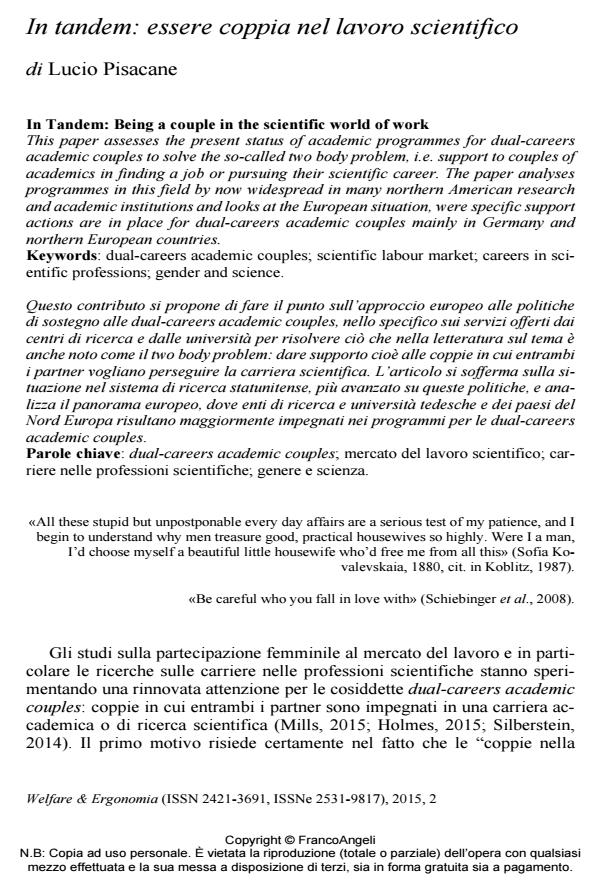In tandem: essere coppia nel lavoro scientifico
Titolo Rivista WELFARE E ERGONOMIA
Autori/Curatori Lucio Pisacane
Anno di pubblicazione 2017 Fascicolo 2015/2 Lingua Italiano
Numero pagine 11 P. 141-151 Dimensione file 177 KB
DOI 10.3280/WE2015-002011
Il DOI è il codice a barre della proprietà intellettuale: per saperne di più
clicca qui
Qui sotto puoi vedere in anteprima la prima pagina di questo articolo.
Se questo articolo ti interessa, lo puoi acquistare (e scaricare in formato pdf) seguendo le facili indicazioni per acquistare il download credit. Acquista Download Credits per scaricare questo Articolo in formato PDF

FrancoAngeli è membro della Publishers International Linking Association, Inc (PILA)associazione indipendente e non profit per facilitare (attraverso i servizi tecnologici implementati da CrossRef.org) l’accesso degli studiosi ai contenuti digitali nelle pubblicazioni professionali e scientifiche
Questo contributo si propone di fare il punto sull’approccio europeo alle politiche di sostegno alle dual-careers academic couples, nello specifico sui servizi offerti dai centri di ricerca e dalle università per risolvere ciò che nella letteratura sul tema è anche noto come il two body problem: dare supporto cioè alle coppie in cui entrambi i partner vogliano perseguire la carriera scientifica. L’articolo si sofferma sulla situazione nel sistema di ricerca statunitense, più avanzato su queste politiche, e analizza il panorama europeo, dove enti di ricerca e università tedesche e dei paesi del Nord Europa risultano maggiormente impegnati nei programmi per le dual-careers academic couples.;
Keywords:Dual-careers academic couples; mercato del lavoro scientifico; carriere nelle professioni scientifiche; genere e scienza.
- Ackers L. (2001). The Participation of Women Researchers in the tmr Programme of the European Commission: An Evaluation. Brussels: European Commission (dg Research).
- Avveduto S., Pisacane L., a cura di (2014). Portrait of a Lady. Women in Science: participation issues and perspectives in a globalized research system. Roma: Gangemi.
- Blossfeld H.-P., Drobnic S. (2001). Careers of couples in contemporary societies: From male breadwinner to dual earner families. Oxford: Oxford University Press.
- Hardill I., Dudleston A. C., Green A. E. and Owen D. W. (1999). Decision Making in Dual-Career Households. In: McKie L., Bowlby S. and Gregory S., eds., Gender, Power and the Household. New York: Macmillan Press, pp. 192-206.
- Hiller D. V., Dyehouse J. (1987). A case for banishing “dual-career marriages” from the research literature. Journal of Marriage and Family, 49(4): 787-95. DOI: 10.2307/351972
- Holmes M. A. (2015). Dual Career, Flexible Faculty. In: Holmes M. A., Connell S. O. and Dutt K., eds., Women in the Geosciences: Practical, Positive Practices Toward Parity. Hoboken, N. J.: John Wiley & Sons, Inc.
- Koblitz A. H. (1987). Careers and Home Life in the 1880s: The Choices of Mathematician Sofia Kovalevskaia. In: Air-Am P. G., Outram D., eds., Uneasy Careers and Intimate Lives: Women in Science, 1789-1979. New Brunswick: Rutgers University Press, pp. 172-90.
- Lucchini M., Saraceno C. e Schizzerotto A. (2007). Dual-earner and dual-career couples in contemporary Italy. Zeitschrift für Familienforschung, 19, 3: 290-310.
- Mills M. J., ed. (2015). Gender and the Work-Family Experience. An Intersection of Two Domains. Berlin: Springer.
- Rapoport R., Rapoport R. N. (1969). The Dual Career Family. A Variant Pattern and Social Change. Human Relations, 22: 3-30.
- Rapoport R., Rapoport R. N. (1971). Dual career families. London: Penguin.
- Rusconi A., Solga H. (2008). A systematic reflection upon dual career couples. wzb Discussion Paper, No. SP I 2008-505.
- Saraceno C. (2007). Introduction to the special issue: Dual-career couples. Zeitschrift für Familienforschung, 19, 3: 255-62.
- Schiebinger L., Davies Henderson A. and Gilmartin S. K. (2008). Dual-Career Academic Couples. What Universities Need to Know. Stanford: Michelle R. Clayman Institute for Gender Research, Stanford University.
- Silberstein L. R. (2014). Dual-career marriage: A system in transition. New York-London: Psychology Press.
- Vohlidalova M. (2011). Academic Duets: on the Professional and Private Lives in Science. Prague: Institute of Sociology of the Czech Academy of Sciences.
- von Ruschkowski E. (2003). Raising Awareness. Science, March 7: http://www.changemag.org/carees/2003/03/raising-awareness.
- Wolf-Wendel L., Twombly S. and Rice S. (1999). Case Studies of Dual Career Couple Policies. Paper presented at the “Annual Meeting of the Association for the Study of Higher Education”, San Antonio.
- Wolf-Wendel L., Twombly S. and Rice S. (2004). The two-body problem: Dual-career-couple hiring practices in higher education. Baltimore: Johns Hopkins University Press.
Lucio Pisacane, In tandem: essere coppia nel lavoro scientifico in "WELFARE E ERGONOMIA" 2/2015, pp 141-151, DOI: 10.3280/WE2015-002011